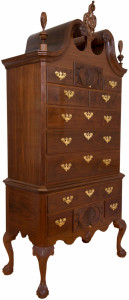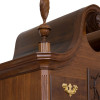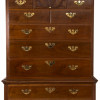- High Chests (Highboys)
- High Chest
High Chest
Member Gallery
Address
Contact
Dimensions: Overall height - 90 inches (measured to the top of the cornice molding) Overall width - 45 3/4 inches (measured at the waist molding) Overall depth - 22 7/8 inches (measured at the waist molding)
Like many period woodworkers, I have always been inspired by the grandeur and grace of the high chests made in Philadelphia in the late 18th century. The design of this piece is based on several Clifton Carteret high chests, one of which is in the Colonial Williamsburg Collection (1975-154). The upper section drawer arrangement was adjusted to provide a more aesthetically appealing appearance. The design of this high chest includes a full bonnet. The upper section contains two secret drawers with internal locking mechanisms.
Construction Details: The sides of the upper and lower sections are full width walnut. All joints were cut with hand tools using period techniques. Although period construction techniques were generally used, drawers are supported in the upper section on frames mortised together instead of the full dust board arrangement that was popular in the 18th century. Drawer dividers were fit from the rear on both the upper and lower sections. Drawer sides were constructed from quarter-sawn poplar to permit tighter tolerances in the fitting process. The goose-neck and waist moldings were produced with various wooden planes or chisels and the surfaces further refined with scrapers. The design of the pediment required much study and analysis of many photographs of Philadelphia examples. The curves of the pediment were developed using geometric construction. Major and minor arcs were constructed and then extended using a Fibonacci expansion. This technique was validated by close study of the Clifton Carteret high chest in the CW collection. The roof of the bonnet was constructed of stained quarter sawn poplar on the outward facing surfaces and quarter-sawn walnut on the inward facing surfaces.
Brasses: The brasses were all period appropriate castings supplied by Ball and Ball. Ball and Ball also supplied the drawer locks and drawer pulls.
Finish: All surfaces except for the carvings were sanded with 220 grit paper following planning and/or scraping operations. A thin coat of boiled linseed oil was next applied to highlight the grain. A shellac finish was then applied. Multiple thin coats of garnet shellac were brushed onto the surface. The final coats of shellac were rubbed out with pumice and then rottenstone. Finally, the surface was given two coats of dark brown paste wax.
Photographer: Vivian Marie Doering



